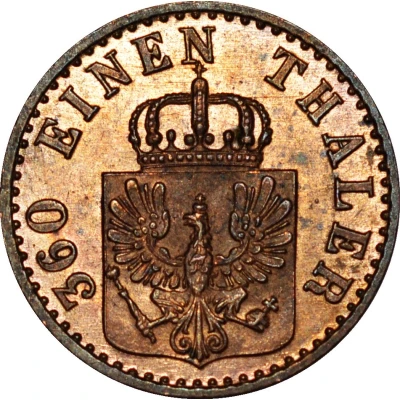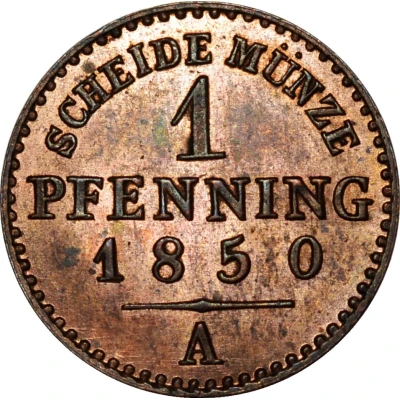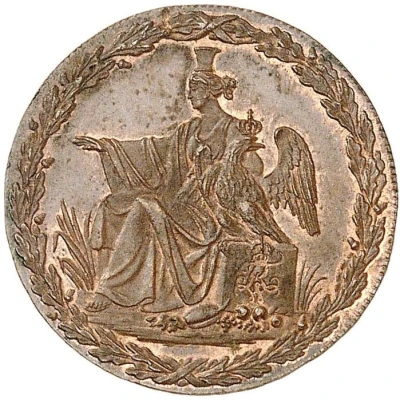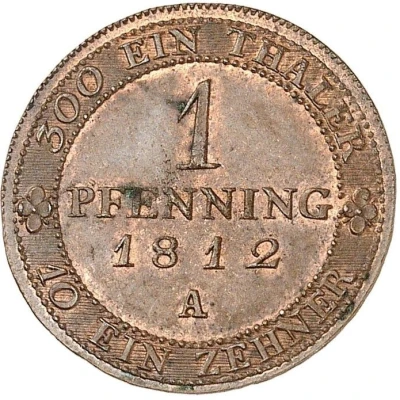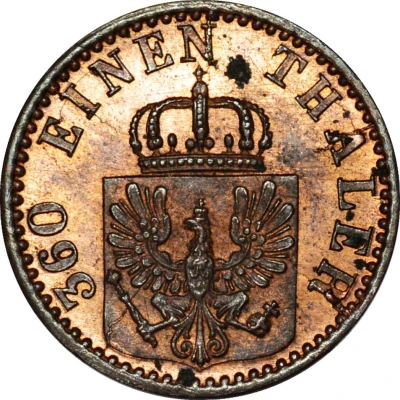
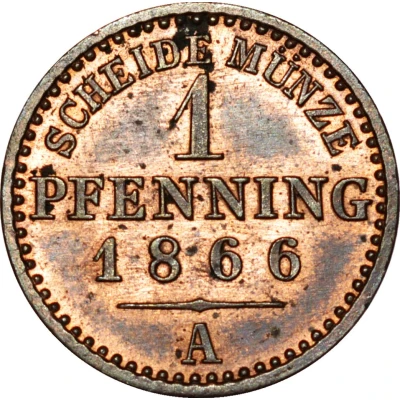

© smy77 (CC BY-NC-SA)
1 Pfenning - William I
| Copper | 1.5 g | 17.75 mm |
| Issuer | Kingdom of Prussia (German States) |
|---|---|
| King | William I (Wilhelm I.) (1861-1888) |
| Type | Standard circulation coin |
| Years | 1861-1873 |
| Value | 1 Pfennig (1⁄360) |
| Currency | Vereinsthaler (1821-1873) |
| Composition | Copper |
| Weight | 1.5 g |
| Diameter | 17.75 mm |
| Thickness | 0.89 mm |
| Shape | Round |
| Technique | Milled |
| Orientation | Medal alignment ↑↑ |
| Demonetized | Yes |
| Updated | 2024-10-05 |
| Numista | N#4228 |
|---|---|
| Rarity index | 10% |
Reverse
3-line inscription with date, mintmark under decoration bar.
Script: Latin
Lettering:
SCHEIDE MÜNZE
1
PFENNING
1866
A
Edge
Plain
Comment
The Kingdom of Prussia (German: Königreich Preußen) was a German kingdom that constituted the state of Prussia between 1701 and 1918.[4] It was the driving force behind the unification of Germany in 1871 and was the leading state of the German Empire until its dissolution in 1918.[4] Although it took its name from the region called Prussia, it was based in the Margraviate of Brandenburg. Its capital was Berlin.[5]The kings of Prussia were from the House of Hohenzollern. Brandenburg-Prussia, predecessor of the kingdom, became a military power under Frederick William, Elector of Brandenburg, known as "The Great Elector".[6][7][8][9] As a kingdom, Prussia continued its rise to power, especially during the reign of Frederick II, more commonly known as Frederick the Great, who was the third son of Frederick William I.[10] Frederick the Great was instrumental in starting the Seven Years' War (1756–63), holding his own against Austria, Russia, France and Sweden and establishing Prussia's role in the German states, as well as establishing the country as a European great power.[11] After the might of Prussia was revealed, it was considered as a major power among the German states. Throughout the next hundred years Prussia went on to win many battles, and many wars.[12]
After the Napoleonic Wars led to the creation of the German Confederation, the issue of unifying the German states caused a number of revolutions throughout the German states, with all states wanting to have their own constitution.[4] Attempts to create a federation remained unsuccessful and the German Confederation collapsed in 1866 when war ensued between its two most powerful member states, Prussia and Austria. The North German Confederation, which lasted from 1867 to 1871, created a closer union between the Prussian-aligned states while Austria and most of Southern Germany remained independent.[4] The North German Confederation was seen as more of an alliance of military strength in the aftermath of the Austro-Prussian War but many of its laws were later used in the German Empire. The German Empire lasted from 1871 to 1918 with the successful unification of all the German states aside from Austria under Prussian hegemony;[4] this was due to the defeat of Napoleon III in the Franco-Prussian War of 1870–71. The war united all the German states against a common enemy, and with the victory came an overwhelming wave of nationalism which changed the opinions of some of those who had been against unification. In 1871, Germany unified into a single country, minus Austria and Switzerland, with Prussia the dominant power.[4]
Prussia is considered the legal predecessor of the unified German Reich (1871–1945) and as such a direct ancestor of today's Federal Republic of Germany.[4] The formal abolition of Prussia, carried out on 25 February 1947 by the Allied Control Council, referred to a tradition of the kingdom as a bearer of militarism and reaction, and made way for the current setup of the German states. However, the Free State of Prussia (Freistaat Preußen), which followed the abolition of the Kingdom of Prussia in the aftermath of , was a major democratic force in Weimar Germany until the nationalist coup of 1932 known as the Preußenschlag.[citation needed] The Kingdom left a significant cultural legacy, today notably promoted by the Prussian Cultural Heritage Foundation (Stiftung Preußischer Kulturbesitz (SPK)), which has become one of the largest cultural organisations in the world.
Interesting fact
One interesting fact about the 1 Pfenning coin from the Kingdom of Prussia (German States) made of Copper and weighing 1.5g is that it was designed by the famous German engraver and medalist, Julius Troschel. Troschel was known for his intricate designs and detail-oriented work, which can be seen in the coin's depiction of King William I on the obverse side. The coin's reverse side features a crowned eagle, which was a common symbol of Prussia during that time.
Price
| Date | Mintage | VG | F | VF | XF | AU | UNC |
|---|---|---|---|---|---|---|---|
| 1861 A | - | - | - | - | - | - | |
| 1862 A | - | - | - | - | - | - | |
| 1863 A | - | - | - | - | - | - | |
| 1864 A | - | - | - | - | - | - | |
| 1865 A | - | - | - | - | - | - | |
| 1866 A | - | - | - | - | - | - | |
| 1867 A | - | - | - | - | - | - | |
| 1867 B | - | - | - | - | - | - | |
| 1868 A | - | - | - | - | - | - | |
| 1868 B | - | - | - | - | - | - | |
| 1868 C | - | - | - | - | - | - | |
| 1869 A | - | - | - | - | - | - | |
| 1870 A | - | - | - | - | - | - | |
| 1871 A | - | - | - | - | - | - | |
| 1871 C | - | - | - | - | - | - | |
| 1873 A | - | - | - | - | - | - | |
| 1873 B | - | - | - | - | - | - |
Values in the table are based on evaluations by sales realized on Internet platforms. They serve as an indication only for 1 Pfenning - William I 1861-1873 coin.
